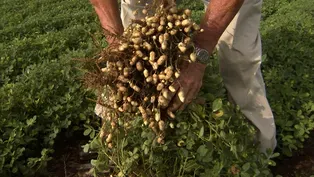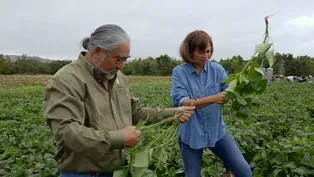
Mendocino Chili Peppers
Clip: 6/30/2023 | 4m 57sVideo has Closed Captions
Bright red chili peppers grown at this Mendocino farm are turned into chili powder.
Bright red chili peppers grown at this Mendocino farm are turned into a spicy and sweet chili powder beloved by chefs. The husband-and -wife team behind Boonville Barn primarily grow espelette peppers, along with about 10 other varieties of specialty chilies that are hard to find elsewhere.
Problems with Closed Captions? Closed Captioning Feedback
Problems with Closed Captions? Closed Captioning Feedback
America's Heartland is presented by your local public television station.
Funding for America’s Heartland is provided by US Soy, Sustainable Agriculture Research and Education, Rural Development Partners, and a Specialty Crop Grant from the California Department of Food and Agriculture.

Mendocino Chili Peppers
Clip: 6/30/2023 | 4m 57sVideo has Closed Captions
Bright red chili peppers grown at this Mendocino farm are turned into a spicy and sweet chili powder beloved by chefs. The husband-and -wife team behind Boonville Barn primarily grow espelette peppers, along with about 10 other varieties of specialty chilies that are hard to find elsewhere.
Problems with Closed Captions? Closed Captioning Feedback
How to Watch America's Heartland
America's Heartland is available to stream on pbs.org and the free PBS App, available on iPhone, Apple TV, Android TV, Android smartphones, Amazon Fire TV, Amazon Fire Tablet, Roku, Samsung Smart TV, and Vizio.
Providing Support for PBS.org
Learn Moreabout PBS online sponsorship♪♪ About 100 miles north of San Francisco, in misty Mendocino County, lies the small town of Boonville and the Boonville Barn Collective.
The farm is owned by Krissy Scommegna and her husband, Gideon Burdick.
It's the largest producer of Espelette chile peppers outside of France.
[Krissy] Boonville is a really great place to grow specifically the Espelette chile, because we have a really similar climate to the Basque region in France, where these peppers are from.
And so, they're used to having hot heat during the day and they like that cooler night.
So, yeah, I mean, we're lucky that the weather's so good right now and it hasn't frosted yet.
So, here on the farm, um, we grow chili peppers that we dry and grind into chili powders, and that's our main crop.
We might only have three acres of peppers, and not all of that is planted in the Espelette pepper, uh, but we really work hard to create some really lovely chili powder that a lot of chefs in the U.S. choose over the French version.
It's a little sweet, a little bit spicy.
Um, in France, it's called Piment d'Espelette but we call ours "Piment d'Ville" to honor the town of Booneville that we're in.
In the same way Champagne must be called "sparkling wine" if it comes from outside the Champagne region of France, Piment d'Espelette has similar restrictions on its name.
Boonville Barn has taken its own approach to the famed pepper and created what Krissy and Gideon describe as a "farm to jar" operation.
All the chili peppers are grown from seed.
They're harvested by hand into buckets.
A tractor then takes them to a nearby greenhouse where they're dried on racks to enrich their flavor.
All the seeds and stems are removed, also by hand, before the peppers go into a dehydrator.
They're ground into chili powder and other products that are packaged and sold around the country to chefs, specialty stores and online.
Though Espelette peppers are their primary crop, Boonville Barn also grows about ten other varieties of specialty chilies that are hard to find elsewhere.
[Krissy] There's red Serrano chilies.
There's an heirloom yellow lica Chile de Árbol, a rare Mexican chili from the Veracruz Mountains called Comapeno Chile.
There's a lot.
And we're really growing chilies for their flavor, not necessarily for heat.
Um, we're not trying to be out here growing the hottest peppers that we can.
Um, we're really looking for those special chilies that add a lot of flavor to the things that people cook.
[Krissy] How big of a piece do you want?
[Gideon] Um, big.
I'm hungry.
Cooking with chili powder is something Krissy and Gideon know a lot about.
In the Basque region, people use Espelette chile powder as commonly as salt and pepper.
Krissy recommends using it anywhere you'd use black pepper to deepen flavors and foods ranging from beans and veggies to one of their favorites- avocado toast.
[Laughter] [Gideon] Cheers.
I have the joy of living with Krissy, and so my favorite way of eating it is on everything, because when you own a chili pepper farm, you tend to use chili pepper in all of your cooking.
[Krissy] Just because something is made with a chili pepper doesn't mean that it's spicy.
There's a lot of peppers out there grown for flavor, and that's really what we focus on here.
Krissy's experience cooking with Espelette chile powder came from working in the kitchen at the Boonville Hotel.
She asked her father's vineyard manager at the time, Nacho Flores, if he could try growing the peppers.
[Krissy] And so, one day in the fall, Nacho came into the kitchen while I was at work with a few bus tubs full of fresh chilies and said, "All right, Krissy, what happens next?"
And then I realized I needed to figure out how to turn these chilies into chili powder.
They've accomplished that and more, with Nacho now leading Boonville Barn's farming operations as foreman, bringing his knowledge of chilies from his native Mexico.
[Nacho] I was just born a farmer.
[Chuckles] Yeah.
Thanks to my dad.
He teach me all I know.
[Gideon] I love seeing our team succeed.
Uh, I think part of being a problem solver is equipping Nacho or Krissy or everyone who's working for us with the tools and the equipment they need to be able to get a really great product to market.
Although chilies are known for their love of the sun, they need water, too.
Boonville Barn is a rain-fed farm, meaning all of their water comes from rain captured in this irrigation pond.
[Krissy] We're constantly trying to figure out different ways to conserve the water we have and to make sure we're growing these chilies in... in a way that we can continue to grow them for as long as possible.
[Gideon] We've got to get them all to red before they can go into the greenhouse.
[Krissy] Yeah, so, like, these, the anchos will be nice and red, and then the mulatos will turn more like chocolate brown, purple.
It's really satisfying to grow something from seed and be able to use that on a regular basis in our own kitchen, and share that with friends, with family and other people and come together around a crop that everyone's pretty excited about.
Video has Closed Captions
A new peanut plant in Alabama is owned by hundreds of local growers. (4m 46s)
Solutions for Urban Agriculture in Southern California
Video has Closed Captions
See how farmers and volunteers are making a difference in southern California. (5m 25s)
Sweet Corn Polenta – Farm to Fork with Sharon Profis
Video has Closed Captions
Learn how to make a Sweet Corn Polenta dish. (5m 10s)
Providing Support for PBS.org
Learn Moreabout PBS online sponsorshipSupport for PBS provided by:
America's Heartland is presented by your local public television station.
Funding for America’s Heartland is provided by US Soy, Sustainable Agriculture Research and Education, Rural Development Partners, and a Specialty Crop Grant from the California Department of Food and Agriculture.














